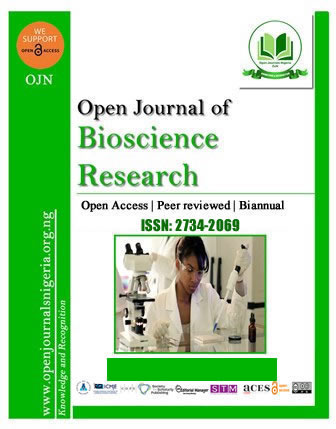IN SILICO AND IN VITRO ANTIMICROBIAL TESTING OF AQUEOUS EXTRACT OF Vernonia amygdalina AGAINST Escherichia coli ISOLATED FROM WISTAR RATS INFECTED WITH Trypanosoma congolense
DOI:
https://doi.org/10.52417/ojbr.v3i2.391Keywords:
Antimicrobial activity of Vernonia amygdalina, Bitter leaves, Escherichia coli, Molecular simulation, Vernonia amygdalina, VernoniosidesAbstract
The study was carried out to investigate the in silico and in vitro antimicrobial activity of Vernonia amygdalina aqueous extract (VAAE) against Escherichia coli on rats already infected with Trypanosoma congolense. Forty Wistar rats of 16 weeks old were used, and were randomly selected into six groups, where n = 5 in groups A, B, D, E and F; n = 15 in group C. Group A: uninfected-untreated; group B: uninfected-treated (500 mg/kgbwt VAAE); group C: infected-untreated; groups D: infected-treated (100 mg/kgbwt VAAE), E: infected-treated (300 mg/kgbwt (VAAE) and F: infected-treated (500 mg/kgbwt (VAAE). Using docking simulation, a number of phytochemicals were screened and identified in the VAAE used in the study. The findings have given an indication of in vitro antimicrobial activity of aqueous extract of Vernonia amygdalina leaves against Escherichia coli. Docking with topoisomerase iv (3FV5) revealed that 3 compounds (−8.5 to – 8.3 kcal/mol) with docking scores lower than the co-crystalized PBE (-6.1kcal/mol). The five topmost docked compounds including vernonioside A22, vernonioside A42, luteolin-7-rutinoside, vernonioside D2 and proline betaine (PBE) with the lowest docking scores exhibited the highest binding tendency with topoisomerase iv, upon interaction analysis. Residues involved in the intermolecular interaction include Asp69, Ile116, Ser117, Leu94, Gly73 Leu89, Arg93, Ile90, Glu46 and Val39 (h-bonds), Val118, Ile90, Met74, Gly73, Arg72, Pro75, Val39, Val165 and Tyr505 (π-π stacking interactions) and Glu46. Our findings revealed the stability of vernonioside A22, vernonioside A42, luteolin-7-rutinoside, vernonioside D2 and proline betaine (PBE) on the target topoisomerase iv in the target organism, which in support of the in vitro study has also shown that Vernonia amygdalina leaves have antimicrobial potential and as such be considered as a formidable source for the search for new drugs against bacteria.
Published
How to Cite
Issue
Section
Copyright (c) 2022 Tom-Otu et al.

This work is licensed under a Creative Commons Attribution 4.0 International License.





















